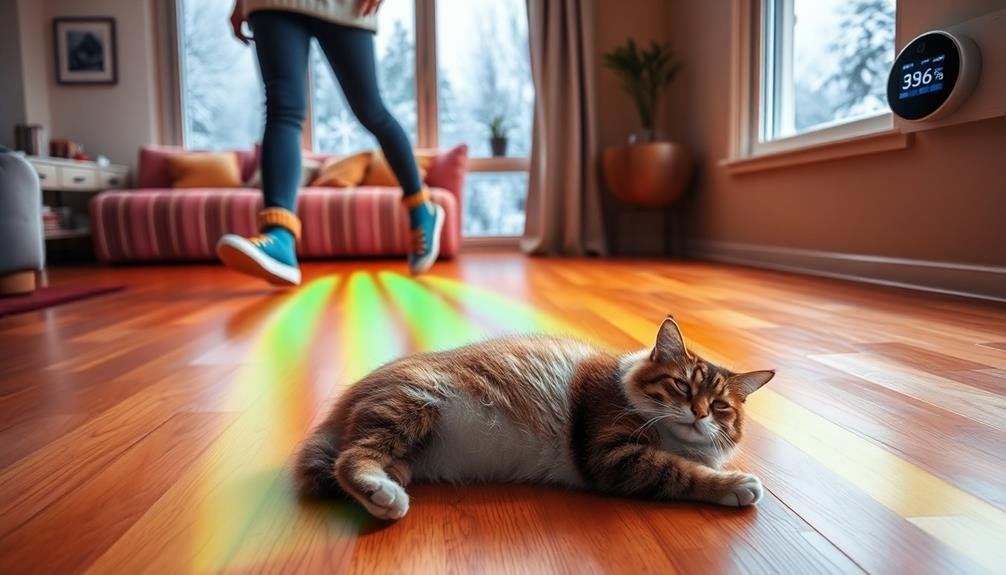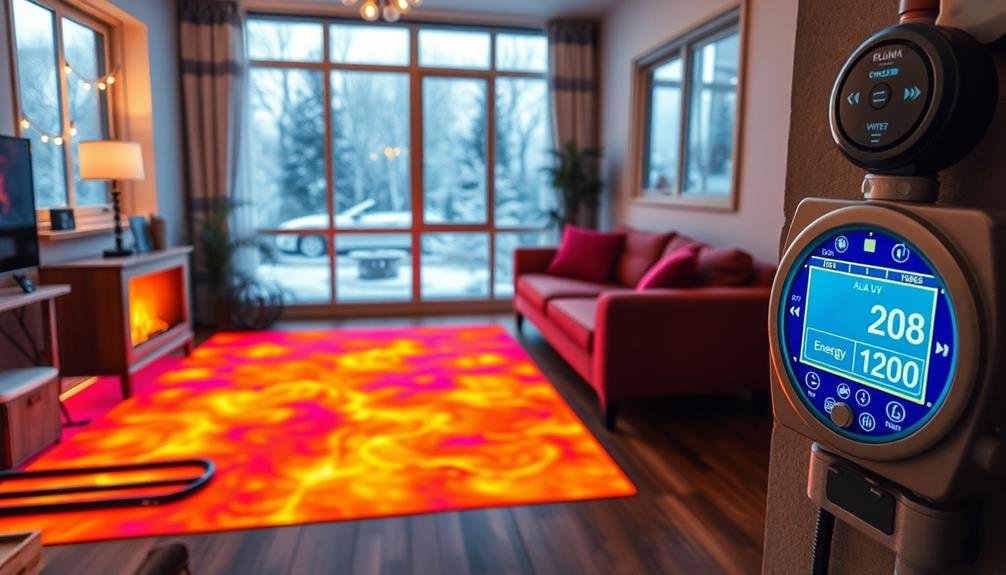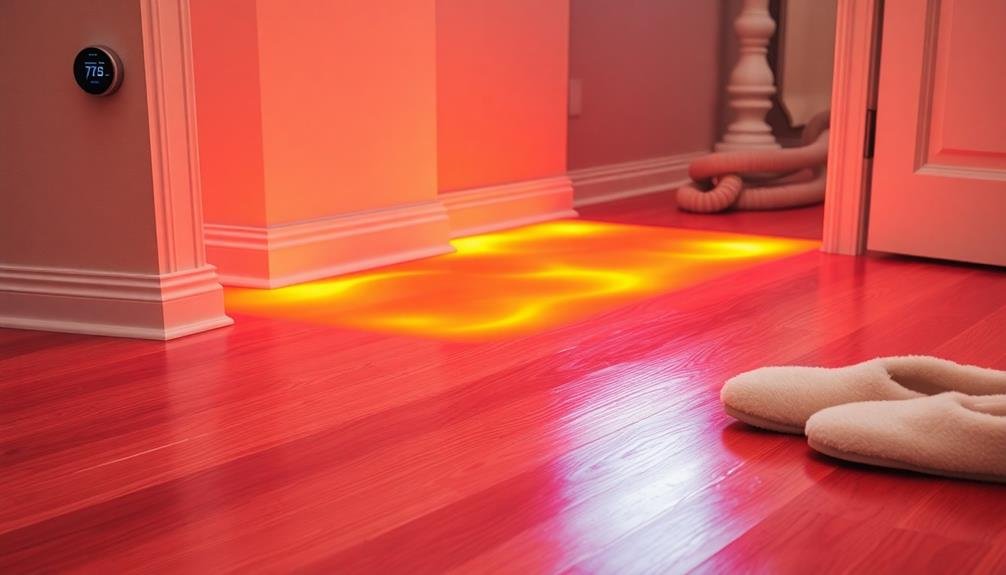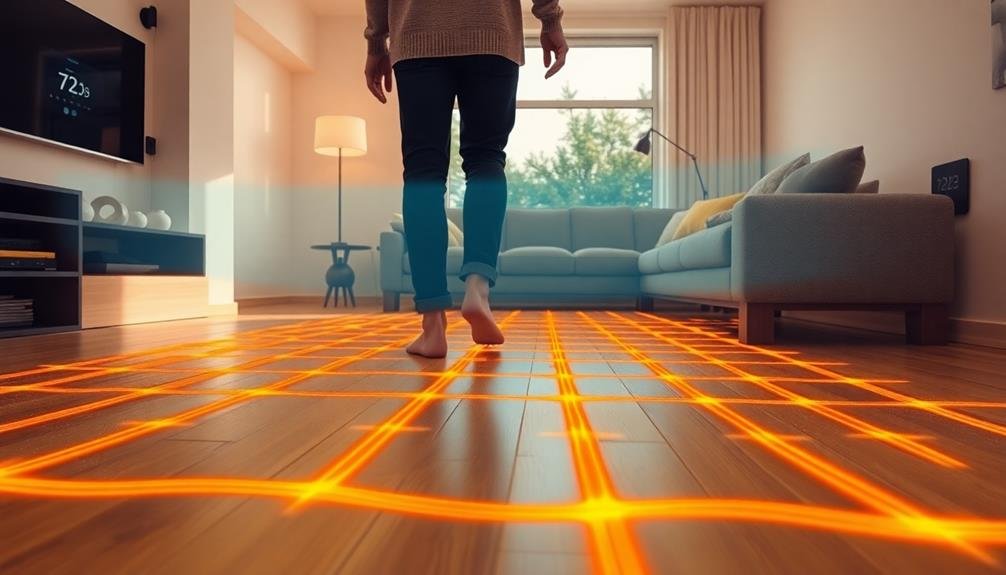Radiant floor heating is a smart choice for your new home, offering consistent warmth and improved energy efficiency. You'll enjoy silent operation, better air quality, and more design flexibility without visible heating elements. While installation costs are higher upfront, you'll save on energy bills in the long run, with potential reductions of up to 25% compared to traditional systems. It's best installed during construction, allowing for proper planning and integration. With minimal maintenance required and a lifespan of 30-50 years, radiant heating provides lasting comfort and value. Discover why this modern heating solution might be the perfect fit for your new home build.
Benefits of Radiant Floor Heating

While traditional heating systems have their merits, radiant floor heating offers several unique advantages for homeowners.
You'll experience consistent, even warmth throughout your home, as heat rises from the floor and distributes uniformly. This eliminates cold spots and drafts common with forced-air systems.
Energy efficiency is another key benefit. Radiant heating operates at lower temperatures than conventional systems, reducing energy consumption and lowering your utility bills.
It's also silent, with no noisy vents or blowers to disrupt your peace.
You'll enjoy improved air quality, as radiant systems don't circulate dust, allergens, or other airborne particles. This is particularly beneficial for allergy sufferers.
The absence of visible heating elements also gives you more design freedom and usable space in your rooms.
Radiant floor heating provides superior comfort. The warmth from below creates a cozy atmosphere, and you can walk barefoot on toasty floors even in winter.
It's ideal for bathrooms, kitchens, and other tiled areas that are typically cold underfoot.
Lastly, these systems are low-maintenance and long-lasting, often outliving traditional heating options.
You'll save on repair and replacement costs over time.
Installation Process and Considerations
Now that you understand the benefits of radiant floor heating, let's explore the installation process and key considerations.
The installation begins with a thorough assessment of your home's structure and insulation. You'll need to choose between hydronic (water-based) or electric systems, depending on your energy source and budget.
For hydronic systems, professionals will install a network of pipes beneath your flooring. They'll connect these pipes to a boiler or water heater. Electric systems involve laying heating cables or mats under the floor. Both methods require careful planning to guarantee even heat distribution.
Consider the flooring material you'll use, as some work better with radiant heating than others. Tile, stone, and concrete are excellent conductors, while hardwood and carpet may reduce efficiency.
You'll also need to factor in the height of the finished floor, as radiant systems can raise it slightly.
Timing is essential; it's best to install radiant heating during new construction or major renovations. You'll need to coordinate with other contractors to guarantee proper integration with your home's systems.
Don't forget to check local building codes and obtain necessary permits before starting the project.
Cost Analysis and Energy Efficiency

When it comes to radiant floor heating, you'll need to weigh the upfront costs against long-term energy savings. Initially, you'll face higher installation expenses compared to traditional heating systems. The cost typically ranges from $6 to $15 per square foot, depending on the type of system and your home's layout.
However, radiant floor heating can greatly reduce your energy bills over time. It's about 25% more efficient than forced-air systems, as it doesn't lose heat through ductwork. You'll also benefit from lower thermostat settings, as radiant heat feels warmer at lower temperatures.
To maximize energy efficiency, consider zoning your system. This allows you to heat only occupied areas, further reducing energy consumption. Additionally, pairing your radiant floor heating with a high-efficiency boiler or heat pump can boost overall system performance.
Don't forget to factor in reduced maintenance costs. With fewer moving parts than traditional systems, radiant floor heating requires less upkeep.
While the initial investment may seem steep, you'll likely recoup costs through energy savings and increased home value in the long run.
Comparing Radiant Vs Traditional Systems
Having examined the cost and efficiency aspects of radiant floor heating, let's explore how it stacks up against traditional heating systems.
Radiant heating offers more consistent warmth throughout your home, as it heats objects and surfaces rather than just the air. This results in fewer cold spots and drafts compared to forced-air systems.
You'll notice improved air quality with radiant heating, as it doesn't circulate dust, allergens, or pollutants like traditional HVAC systems do. It's also quieter, eliminating the noise of furnaces cycling on and off or air rushing through vents.
Radiant systems are more energy-efficient, often reducing heating costs by 20-30% compared to forced-air systems.
However, traditional systems have some advantages. They're typically less expensive to install initially and can provide both heating and cooling. They're also easier to retrofit in existing homes.
Forced-air systems can heat or cool a space more quickly than radiant systems, which may take longer to adjust temperatures.
Ultimately, your choice depends on your priorities: long-term comfort and efficiency versus lower upfront costs and faster temperature changes.
Consider your climate, budget, and personal preferences when deciding between radiant and traditional heating systems.
Maintenance and Longevity

Durability is a key advantage of radiant floor heating systems. You'll find that these systems require minimal maintenance and can last for decades. Unlike traditional HVAC systems with numerous moving parts, radiant heating has fewer components that can wear out or break down.
You'll appreciate the longevity of radiant floor heating:
| Aspect | Radiant Heating | Traditional HVAC |
|---|---|---|
| Lifespan | 30-50 years | 15-20 years |
| Annual Maintenance | Minimal | Regular |
| Repairs | Rare | More frequent |
| Energy Efficiency | Maintains over time | Decreases with age |
| Replacement Parts | Few | Many |
To keep your radiant system running smoothly, you'll only need to perform a few simple tasks. Regularly check the boiler pressure, bleed radiators if necessary, and schedule annual professional inspections. These steps will help maintain peak performance and extend the system's lifespan.
If you're building a new home, consider the long-term benefits of radiant floor heating. You'll enjoy consistent warmth, energy efficiency, and peace of mind knowing that your heating system will require minimal upkeep and serve you well for years to come.
Frequently Asked Questions
Can Radiant Floor Heating Be Installed in Existing Homes?
Yes, you can install radiant floor heating in existing homes. You'll need to remove existing flooring, lay the heating system, and then reinstall flooring. It's more disruptive than new construction, but it's definitely possible.
Is Radiant Floor Heating Safe for Pets and Children?
Yes, radiant floor heating is safe for pets and children. You'll find it's a gentle, even heat that won't burn paws or feet. There's no exposed heating elements, so you don't need to worry about accidents.
How Long Does It Take for Radiant Floor Heating to Warm Up?
You'll find that radiant floor heating typically takes 30 minutes to 2 hours to warm up fully. It's slower than forced air systems, but once it's warm, you'll enjoy consistent, comfortable heat throughout your space.
Can Radiant Floor Heating Be Used for Cooling in Summer?
You can't typically use radiant floor heating for cooling. While it's great for warmth, it's not designed to cool. For summer comfort, you'll need to rely on other cooling methods like air conditioning or fans.
Are There Any Flooring Materials Incompatible With Radiant Floor Heating?
You'll find some flooring materials don't work well with radiant heating. Avoid thick carpets, rubber, and vinyl, as they insulate too much. Hardwood can be tricky; engineered wood is better. Tile and stone are excellent choices.
In Summary
You've explored the advantages of radiant floor heating for your new home. It's efficient, comfortable, and can save you money long-term. While installation requires careful planning, the benefits often outweigh the initial costs. You'll enjoy consistent warmth and lower energy bills. Don't forget to reflect on maintenance needs, but remember that these systems typically last longer than traditional heating. Ultimately, radiant floor heating could be the smart choice for your new home's comfort and value.





Leave a Reply